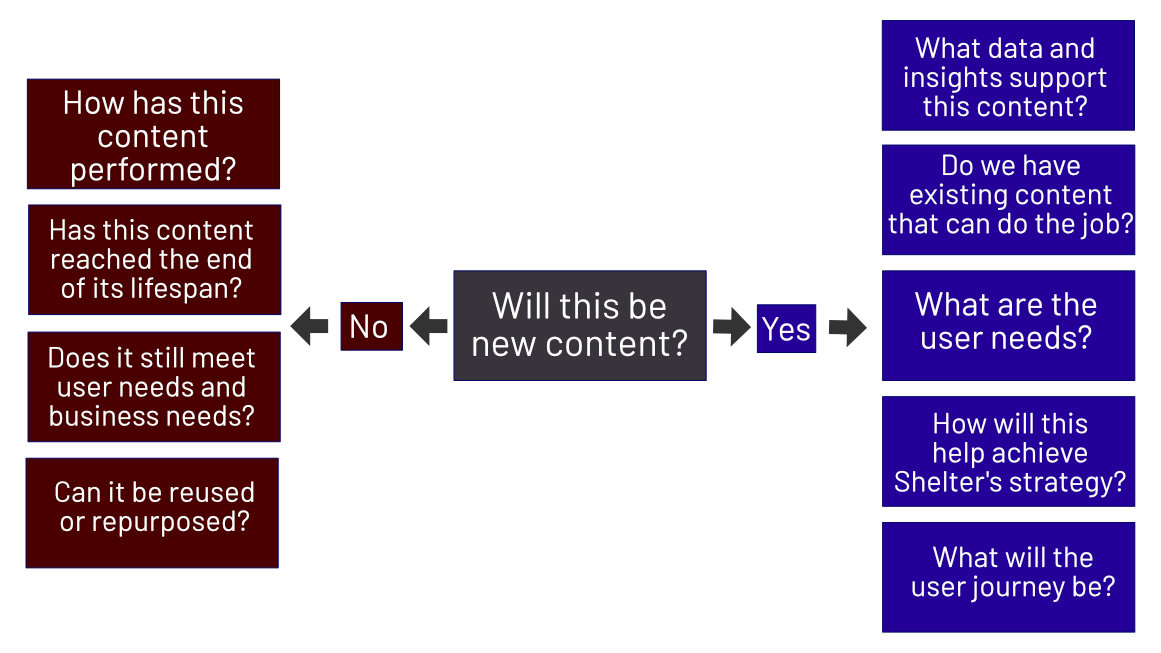How we decide what to do and what not to do
Two questions facing any organisation who has ever built a website: What content should we publish? and how can we get better at content publishing?
Here at Shelter, our content operations are based on our ability to answer these questions. We want to be able to identify what our content priorities should be. And we want to continually improve the planks of content ops - our processes, tools, and governance.
Let’s look at these two areas: the everyday decisions and the longer-term choices we make to build our content ops muscles.
Principled and purposeful publishing
In deciding what we’ll create and publish - and the approach we’ll take in creating it - we follow the Digital team’s working principles, which have proven themselves invaluable as guiding posts.
We also use these question rubrics to focus specifically on content work and whether it’s needed:
For new content requests
What are the identified (as in researched) user needs this content will meet?
Does this content already exist, either in ready-to-go form or similar enough that it can be copied and amended to meet the user needs?
Which Shelter strategies (organisational, content strategies, or others) will this content help deliver?
What data and insight supports the need for this content?
What will the user journey be? How will they find the content and what will they do after they find it?
For existing content
How has this content performed against its intended purpose?
Has this content reached the end of its lifespan? 'Evergreen' content is content that doesn’t go out-of-date. If analysis shows it still has value for visitors, we consider why we’d change or remove it.
Should it be replaced, updated or retired?
Can it be reused or repurposed?

The question tree we apply to content requests
Prioritising our work
In the same way we work on all content, we prioritise content ops work with specific and realistic goals that is informed by our content strategy, user needs, research and data.
Tasks that are too broad or too general are broken into smaller tasks with clearly defined goals.
These are added to a product backlog, and Shelter’s Head of Content, Head of Digital, and Content Operations Manager then decide which tasks will be worked on and when.
Timings are planned to align with our product roadmaps. Work is done iteratively using a test and learn approach, as part of our cross-organisational product team.
Growing our content capabilities
Content ops is all about putting in place the foundations needed to create, manage, publish and govern content at scale. And with lots of teams of editors working on many different types of content, things can get complicated quickly.
Any complex system that works most likely evolved from a smaller, simpler system that worked first. That's why we prefer to use a test and learn approach that starts small then builds on and improves processes as our content ecosystem develops.
We have four motivations behind our efforts to build strong content operations:
We aim to move towards increased devolved publishing
We maintain a focus on our users’ needs
We aim to scale digital at Shelter
We consistently improve our business models - ways we create, deliver and capture value for our users against our strategy.
By prioritising these goals, our intent is to deliver the best ROI on our software and empower our content teams to effectively meet the challenge of Shelter’s strategy.
Content ops work generally falls into one of the following categories:
People - training (CMS, tone of voice, brand), defining clear roles, responsibilities and structure, and assessing skills
Process – documenting and improving workflows specific to different content teams, updating style guides and tone of voice
Technology – developing features, tools and documentation to run the CMS effectively
Related
What is content governance and why it’s crucial to our work
How user journeys factor into our content work
Contact us about the digital framework
Have a question or comment? Found a bug? Or maybe you’d like to contribute to the framework? Use our contact form to get in touch.
